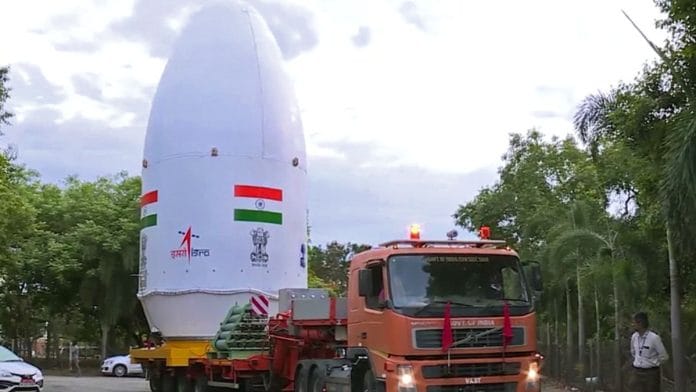New Delhi: What is India doing differently this time to soft-land on the moon’s surface, thereby becoming only the fourth country in the world to do so?
As Chandrayaan-3 prepares to blast off from Andhra Pradesh’s Sriharikota at 2.35 pm on 14 July, the Indian Space Research Organisation (ISRO) will be mindful of Chandrayaan-2’s failure to put lander Vikram on the moon’s surface four years ago.
ISRO Chairman S. Somanath said Monday that Chandrayaan-2’s problem was its limited ability to “handle parameter variation or dispersion”.
“What have we done this time? We have expanded on that. We have looked at what can go wrong… Instead of a success-based design, we are doing a failure-based design in Chandrayaan-3. What all can fail, and how to protect it? This is the approach we have taken,” Somanath said Monday.
Of the many things ISRO has done this time around, is to expand the landing area by half a kilometer by half a kilometer. “To four by 2.5 kilometre… Fur kilometer along the track and 2.5 kilometre width. It can land anywhere,” Somanath said.
VIDEO | "The ability to handle parameter variation or dispersion was very limited in Chandrayaan-2. So, instead of success-based design, we are doing a failure-based design in Chandrayaan-3. What all can fail, and how to protect it — this is the approach that we have taken," says… pic.twitter.com/GnpHAUbyt2
— Press Trust of India (@PTI_News) July 10, 2023
In September 2019, Vikram made a hard-landing, or crashed, 500 metres from the designated site on the lunar surface due to a deviation in the parameters in the final stage of its descent.
In Lok Sabha that November, junior space minister Jitendra Singh had said: “The first phase of descent was performed nominally from an altitude of 30 km to 7.4 km above the moon surface. The velocity was reduced from 1683 m/s to 146 m/s.”
“However, during the second phase of descent, the reduction in velocity was more than the designed value.
“Due to this deviation, the initial conditions at the start of the fine braking phase were beyond the designed parameters. As a result, Vikram hard-landed within 500 m of the designated landing site,” Singh said.
Chandrayaan-2, which took off on 22 July in 2019, was India’s first attempt to carry out a soft-landing on the moon, that too in its unexplored South Pole.
Due to the unsuccessful landing, the indigenously developed rover, Pragyan — meant to explore a region near the south pole of the moon — could also not be rolled out.
Four years on, Chandrayaan-3 will attempt to demonstrate end-to-end capability in safe landing and roving on the lunar surface.
The spacecraft, which will be launched by LVM3 (Launch Vehicle Mark-III) (earlier referred as GSLV Mk III), is also composite of three modules — propulsion, lander, and rover (which is housed inside the lander).
The soft-landing — when a spacecraft lands intact — will be attempted sometime in August. The mission will also carry scientific instruments to study the thermo-physical properties of the lunar regolith, lunar seismicity, lunar surface plasma environment and elemental composition in the vicinity of the landing site.
Jirendra Singh is upbeat this time too. An official release recently quoted him as saying: “India can no longer wait to be left behind in its march to the Moon… There is tremendous excitement across the country about the launch of Chandrayaan-3, particularly because Chandrayaan-2 Mission could not yield the desired results because of a lapse just about 13 minutes after Spacecraft began its descent on September 6, 2019. Prime Minister Narendra Modi was personally present at Sriharikota to witness the event.”
The minister of science and technology added the spacecraft had undergone a few changes to increase the robustness of the lander.
Also read: India’s next moon mission Chandrayaan-3 to take off on 14 July






